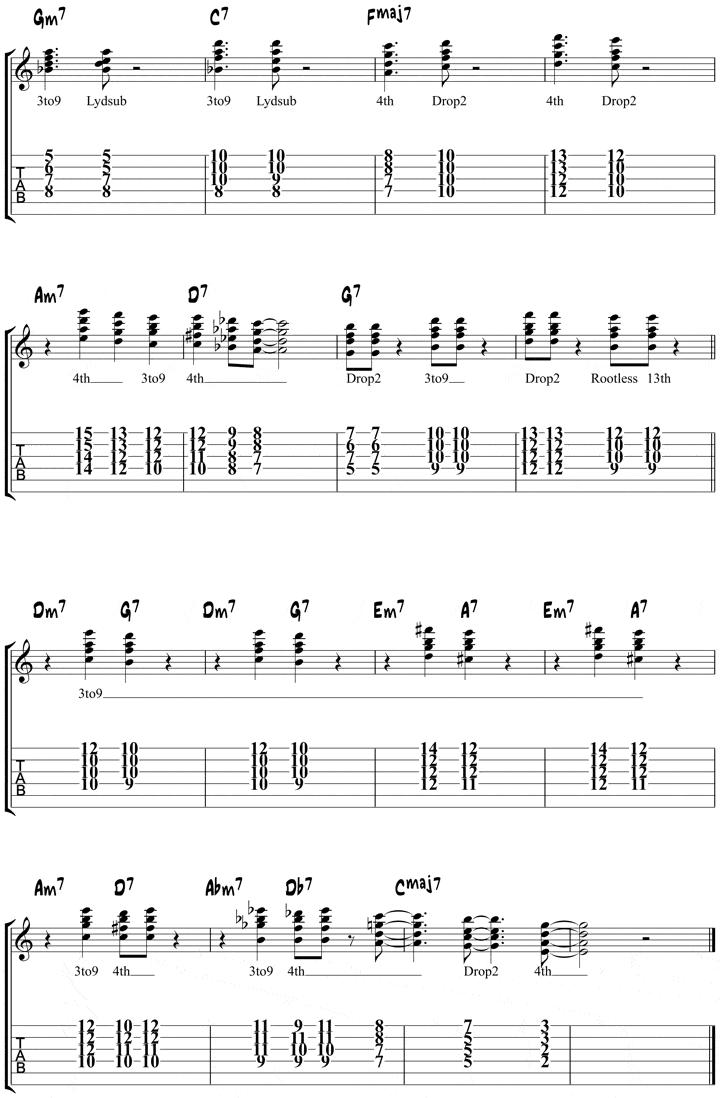Satin Doll Walking Bass Guitar Pdf Free Download

The Ellington/Strayhorn tune Satin Doll is a standard that you need to have in your repertoire. It is also a great standard if you want to work on some easy jazz chords and playing II V progressions, since the progression is mostly made up of one bar II Vs.
DICTIONARY (FREE eBOOK)Download now and learn 244 chord shapes! Learn a chord study over Satin Doll that uses many common jazz guitar chord shapes. Contrary motion, back cycles, walking bass lines, modal chord scales, chord.
In this lesson I am going to go over two sets of easy jazz chords that you can use to comp Satin Doll, namely two versions of shell-voicings. They work really well for Freddie Green rhythm guitar, but are also a great place to start and something that you can build a lot on. This is what I demonstrate with an example at the end of the video adding a lot more color and melodic material to the way I comp it.
The Song and the Form
When learning a song like Satin Doll it is extremely useful to also take the form into consideration. In this case Satin Doll is a 32 bar AABA form.
If you realize that it is an AABA then you also realize that you only need to know the A and the B parts by heart to know the entire progression.
A II V is one unit
Another thing that is very practical is to think of the II V progressions as one thing. Most of the progressions in Satin Doll are one bar II V progressions and by thinking of those as one progression you make it a lot easier to both play and remember.
Shell Voicings for Satin Doll
A Shell voicing is a chord voicing containing the root, 3rd and 7th of the chord.
In Jazz harmony this is enough to spell out the color and the function of the chord most of the time and is a great way to play the basic progression.
Shell voicings are also very useful as a starting point where you can add more melodic material on top in terms of other chord tones or extensions.
In example 1 I have written out the first A part played with shell voicings around fret 10:
Notice that there are two different sets of II V voicings used: One with the m7 root on the 6th string and the other with the m7 root on the 5th string.
The Bridge in the same position
Now that we have an A-part covered then the next thing to sort out is the bridge:
The 2nd set of voicings
A good way to expand the options is to take a look at what the A-part might be with the other II V set.
This is shown in example 3:
For practical reasons I have the same chords in use in the turnaround. After all music is not an exact science…
Adding Variation and Melody chords
The next step is to start expanding the voicings. The way I am going to do that is by taking a shell-voicing and add extensions on top of it.
For the Dm7 and G7 voicings in the 10th fret this would be: Martin luther king i have a dream speech mp3.
For the other II V set we have these options
Putting the variations to use
To get used to improvising with this material it can be a good idea to first just improvise some melodies using a single II V as I do in the video.
After this you can also start making exercises such as this:
Here I am playing the chords on 1 and 3 and then adding an extra melody note in between. The goal is to add a strong melody on top of the chords.
Shell-voicings for Chord Melody
If you want to use this material in chord melody arrangements then you can check out this WebStore lesson on Chord Melody arranging:
Get a free E-book
If you want to download a Free E-book of 15 II Valt I licks then subscribe to my newsletter:
Download the PDF
You can also download the PDF of my examples here:
If you have any questions, comments or suggestions for topics then please let me know. Leave a comment on the video or send me an e-mail. That is the best way for me to improve my lessons and make them fit what you are searching for.
Please subscribe to my YouTube channel and feel free to connect with me via Instagram,TwitterGoogle+ or Facebook to keep up to date with new lessons, concerts and releases.